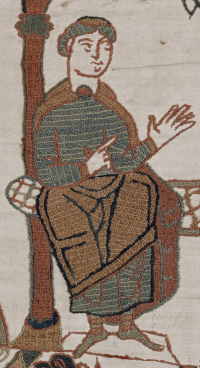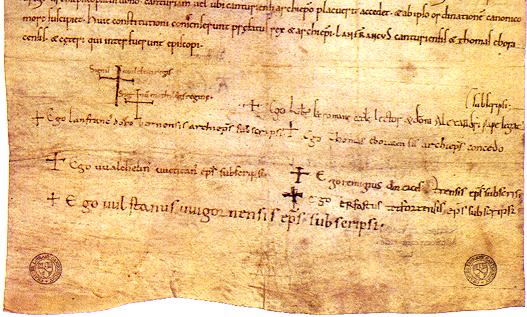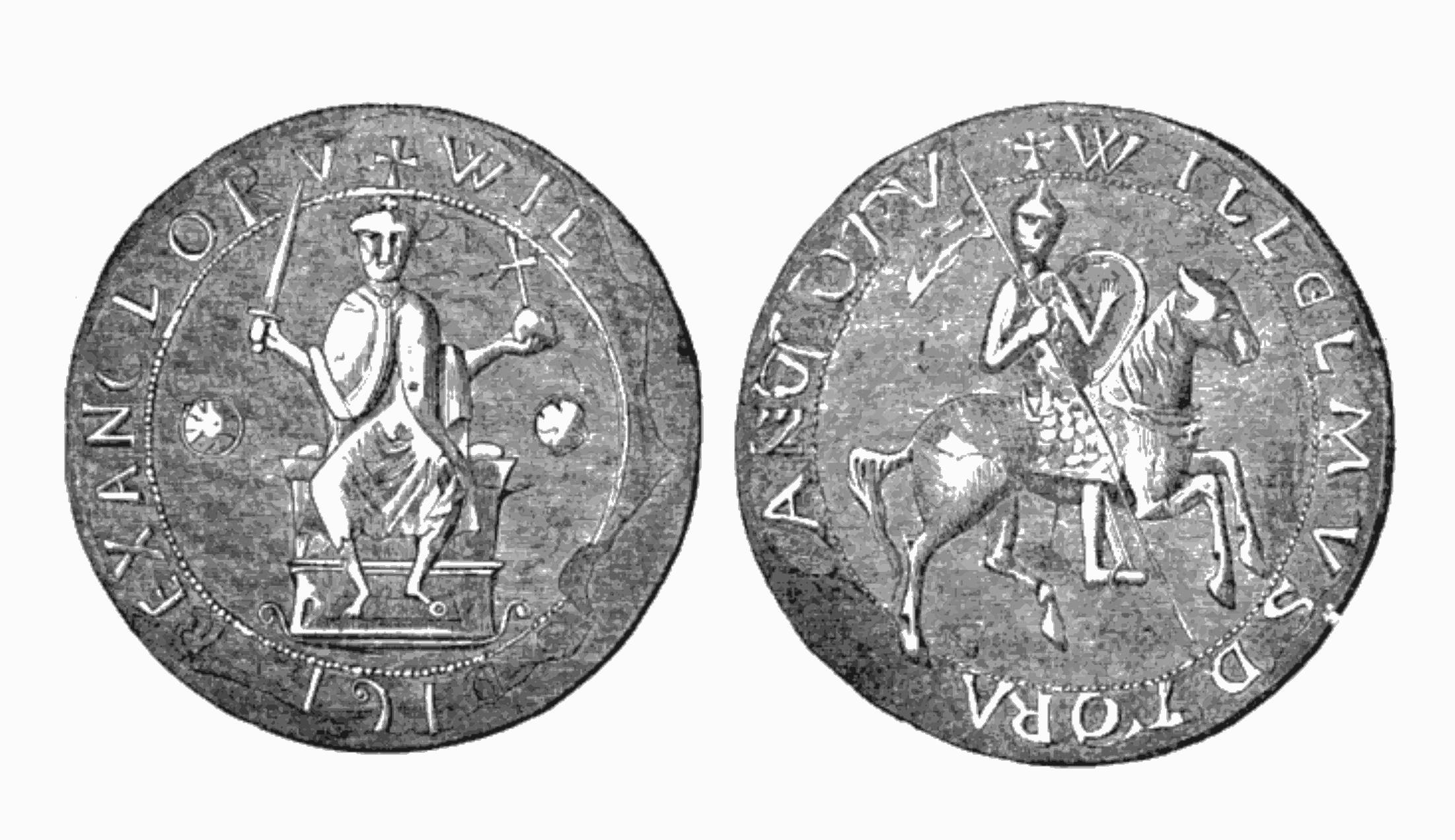|
1088
Year 1088 ( MLXXXVIII) was a leap year starting on Saturday of the Julian calendar. Events By place Europe * Almoravid forces (supported with fighters from local Andalusian provinces), under Sultan Yusuf ibn Tashfin, besiege Aledo, but are forced to retreat, by the arrival of Spanish troops of King Alfonso VI ("the Brave") of Castile. * Catalonian troops, under Count Berenguer Ramon II, reconquer Tarragona (lost again in 1108). He will rule Catalonia with his 6-year-old nephew Ramon Berenguer III, until he comes of age. England * Spring – A rebellion led by William the Conqueror's half-brothers Odo of Bayeux and Robert (2nd Earl of Cornwall), begins against King William II with the aim to remove him from the throne. Odo's revolt in Kent and Sussex is supported by nobles across the country. * The Worcestershire rebellion led by Robert de Lacy (a son of Ilbert de Lacy) is dealt with quickly by Wulfstan, bishop of Worcester, who calls on those knights an ... [...More Info...] [...Related Items...] OR: [Wikipedia] [Google] [Baidu] |
Rebellion Of 1088
The Rebellion of 1088 occurred after the death of William the Conqueror and concerned the division of lands in the Kingdom of England and the Duchy of Normandy between his two sons William Rufus and Robert Curthose. Hostilities lasted from three to six months starting around Easter of 1088. Background William on his deathbed in 1087 decided how his sons would inherit the lands of his native Normandy and recently conquered England. His eldest son Robert was made Duke of Normandy and his third eldest son (second eldest surviving son) William Rufus was made King of England. This came to pass on William's death. The division of William the Conqueror's lands into two parts presented a dilemma for those nobles who held land on both sides of the English Channel. Since the younger William and his brother Robert were natural rivals, these nobles worried that they could not hope to please both of their lords, and thus ran the risk of losing the favour of one ruler or the other, or ... [...More Info...] [...Related Items...] OR: [Wikipedia] [Google] [Baidu] |
Almoravid Dynasty
The Almoravid dynasty () was a Berber Muslim dynasty centered in the territory of present-day Morocco. It established an empire that stretched over the western Maghreb and Al-Andalus, starting in the 1050s and lasting until its fall to the Almohads in 1147. The Almoravids emerged from a coalition of the Lamtuna, Gudala, and Massufa, nomadic Berber tribes living in what is now Mauritania and the Western Sahara, traversing the territory between the Draa, the Niger, and the Senegal rivers. During their expansion into the Maghreb, they founded the city of Marrakesh as a capital, . Shortly after this, the empire was divided into two branches: a northern one centered in the Maghreb, led by Yusuf ibn Tashfin and his descendants, and a southern one based in the Sahara, led by Abu Bakr ibn Umar and his descendants. The Almoravids expanded their control to al-Andalus (the Muslim territories in Iberia) and were crucial in temporarily halting the advance of the Christian kingdoms in ... [...More Info...] [...Related Items...] OR: [Wikipedia] [Google] [Baidu] |
Odo Of Bayeux
Odo of Bayeux (died 1097) was a Norman nobleman who was a bishop of Bayeux in Normandy and was made Earl of Kent in England following the Norman Conquest. He was the maternal half-brother of duke, and later king, William the Conqueror, and was, for a time, William's primary administrator in the Kingdom of England, although he was eventually tried for defrauding William's government. It is likely Odo commissioned the Bayeux Tapestry, a large tableau of the Norman Conquest, perhaps to present to his brother William. He later fell out with his brother over Odo's support for military adventures in Italy. William, on his deathbed, freed Odo. Odo died in Palermo, Sicily, on the way to crusade. Early life Odo was the son of William the Conqueror's mother Herleva and Herluin de Conteville. Count Robert of Mortain was his younger brother. There is uncertainty about his birth date. Some historians have suggested he was born around 1035. Duke William made him bishop of Bayeux in 1 ... [...More Info...] [...Related Items...] OR: [Wikipedia] [Google] [Baidu] |
William The Conqueror
William the Conqueror (Bates ''William the Conqueror'' p. 33– 9 September 1087), sometimes called William the Bastard, was the first Norman king of England (as William I), reigning from 1066 until his death. A descendant of Rollo, he was Duke of Normandy (as William II) from 1035 onward. By 1060, following a long struggle, his hold on Normandy was secure. In 1066, following the death of Edward the Confessor, William invaded England, leading a Franco-Norman army to victory over the Anglo-Saxon forces of Harold Godwinson at the Battle of Hastings, and suppressed subsequent English revolts in what has become known as the Norman Conquest. The rest of his life was marked by struggles to consolidate his hold over England and his continental lands, and by difficulties with his eldest son, Robert Curthose. William was the son of the unmarried Duke Robert I of Normandy and his mistress Herleva. His Legitimacy (family law), illegitimate status and youth caused some difficulties for h ... [...More Info...] [...Related Items...] OR: [Wikipedia] [Google] [Baidu] |
Lanfranc
Lanfranc, OSB (1005 1010 – 24 May 1089) was an Italian-born English churchman, monk and scholar. Born in Italy, he moved to Normandy to become a Benedictine monk at Bec. He served successively as prior of Bec Abbey and abbot of St Stephen's Abbey in Caen, Normandy and then as Archbishop of Canterbury in England, following its conquest by William the Conqueror. He is also variously known as (), (), and (). In his lifetime, he was regarded as the greatest theologian of his generation. Early life Lanfranc was born in the early years of the 11th century at Pavia, where later tradition held that his father, Hanbald, held a rank broadly equivalent to magistrate. He was orphaned at an early age. Lanfranc was trained in the liberal arts, at that time a field in which northern Italy was famous. There is little or no evidence to support the myth that his education included much in the way of Civil Law, and none that links him with Irnerius of Bologna as a pioneer in the re ... [...More Info...] [...Related Items...] OR: [Wikipedia] [Google] [Baidu] |
De Lacy
de Lacy (Laci, Lacie, Lascy, Lacey, Lassey) is the surname of an old Norman family which originated from Lassy, Calvados. The family took part in the Norman Conquest of England and the later Norman invasion of Ireland. The name is first recorded for Hugh de Lacy (1020–1085). His sons, Walter and Ilbert, left Normandy and travelled to England with William the Conqueror. The awards of land by the Conqueror to the de Lacy sons led to two distinct branches of the family: the northern branch, centred on Blackburnshire and west Yorkshire was held by Ilbert's descendants; the southern branch of Marcher Lords, centred on Herefordshire and Shropshire, was held by Walter's descendants. Until 1361, the northern branch of the family held the great Lordship of Bowland before it passed through marriage to the Duchy of Lancaster. They were also Barons of Pontefract and later (via two female lines) Earls of Lincoln. The southern branch of the family became substantial landholders in the ... [...More Info...] [...Related Items...] OR: [Wikipedia] [Google] [Baidu] |
Berenguer Ramon II, Count Of Barcelona
Berenguer Ramon II "the Fratricide" (1053/54 – 1097/99) was count of Barcelona from 1076 to 1097. He was the son of Ramon Berenguer I and Almodis of La Marche, and initially ruled jointly with his twin brother Ramon Berenguer II. Life Born in 1053 or 1054, Berenguer Ramon succeeded his father Ramon Berenguer I "the Old" in 1076 to co-rule with his twin brother Ramon Berenguer II. The twins failed to cooperate, leading Pope Gregory VII to appeal for their reconciliation in 1079. The Catalonian possessions were divided between them, against the will of their late father, and it was agreed that the brothers would alternate their residence at the palace in Barcelona every six months. When the first agreement inevitably fell through, a second was reached in December of 1080. Ramon Berenguer II was killed two years later while hunting in the woods on 5 December 1082. Berenguer Ramon II, who became the sole ruler of Catalonia for the next four years, was popularly suspected of or ... [...More Info...] [...Related Items...] OR: [Wikipedia] [Google] [Baidu] |
William II Of England
William II (; – 2 August 1100) was List of English monarchs, King of England from 26 September 1087 until his death in 1100, with powers over Duchy of Normandy, Normandy and influence in Kingdom of Scotland, Scotland. He was less successful in extending control into Wales. The third son of William the Conqueror, he is commonly referred to as William Rufus (' being Latin for "the Red"), perhaps because of his ruddy appearance or, more likely, due to having red hair. William was a figure of complex temperament, capable of both bellicosity and flamboyance. He did not marry or have children, which – along with contemporary accounts – has led some historians to speculate on homosexuality or bisexuality. He died after being hit by an arrow while hunting. Circumstantial evidence in the behaviour of those around him – including his younger brother Henry I of England, Henry I – raises strong, but unproven, suspicions of murder. Henry immediately seized the treasury and had h ... [...More Info...] [...Related Items...] OR: [Wikipedia] [Google] [Baidu] |
Robert, Count Of Mortain
Robert, Count of Mortain, first Earl of Cornwall of 2nd creation (–) was a Norman nobleman and the half-brother (on their mother's side) of King William the Conqueror. He was one of the very few proven companions of William the Conqueror at the Battle of Hastings and as recorded in the Domesday Book of 1086 was one of the greatest landholders in his half-brother's new Kingdom of England. Life Robert was the son of Herluin de Conteville and Herleva of Falaise and brother of Odo of Bayeux.Detlev Schwennicke, ''Europäische Stammtafeln: Stammtafeln zur Geschichte der Europäischen Staaten'', Neue Folge, Band III Teilband 4 (Marburg, Germany: Verlag von J. A. Stargardt, 1989), Tafel 694B Robert was born in Normandy, a half-brother of William the Conqueror. and was probably not more than a year or so younger than his brother Odo, born . About 1035, Herluin, as Vicomte of Conteville, along with his wife Herleva and Robert, founded Grestain Abbey. Count of Mortain Around 1049 ... [...More Info...] [...Related Items...] OR: [Wikipedia] [Google] [Baidu] |
Alfonso VI Of León And Castile
Alfonso VI (1 July 1109), nicknamed the Brave (''El Bravo'') or the Valiant, was king of Kingdom of León, León (10651109), Kingdom of Galicia, Galicia (10711109), and Kingdom of Castile, Castile (10721109). After the conquest of Toledo, Spain, Toledo in 1085, Alfonso proclaimed himself (most victorious Kingdom of Toledo (Crown of Castile), king of Toledo, and of Spain and Galicia). This conquest, along with El Cid's taking of Taifa of Valencia, Valencia would greatly expand the territory and influence of the Leonese/Castilian realm, but also provoked an Almoravid invasion that Alfonso would spend the remainder of his reign resisting. The Leonese and Castilian armies suffered decisive defeats in the battles of Battle of Sagrajas, Sagrajas (1086), Battle of Consuegra, Consuegra (1097) and Battle of Uclés (1108), Uclés (1108), in the latter of which his only son and heir, Sancho Alfónsez, died, and Valencia was abandoned but Toledo remained part of an expanded realm that he ... [...More Info...] [...Related Items...] OR: [Wikipedia] [Google] [Baidu] |
Fyrd
A fyrd was a type of early Anglo-Saxon army that was mobilised from freemen or paid men to defend their Shire's lords estate, or from selected representatives to join a royal expedition. Service in the fyrd was usually of short duration and participants were expected to provide their own arms and provisions. The composition of the fyrd evolved over the years, particularly as a reaction to raids and invasions by the Vikings. The system of defence and conscription was reorganised during the reign of Alfred the Great, who set up 33 fortified towns (or burhs) in his kingdom of Wessex. The amount of taxation required to maintain each town was laid down in a document known as the Burghal Hidage. Each lord had his individual holding of land assessed in hides. Based on his land holding, he had to contribute men and arms to maintain and defend the burhs. Non-compliance with this requirement could lead to severe penalties. Ultimately the fyrd consisted of a nucleus of experienced so ... [...More Info...] [...Related Items...] OR: [Wikipedia] [Google] [Baidu] |
London
London is the Capital city, capital and List of urban areas in the United Kingdom, largest city of both England and the United Kingdom, with a population of in . London metropolitan area, Its wider metropolitan area is the largest in Western Europe, with a population of 14.9 million. London stands on the River Thames in southeast England, at the head of a tidal estuary down to the North Sea, and has been a major settlement for nearly 2,000 years. Its ancient core and financial centre, the City of London, was founded by the Roman Empire, Romans as Londinium and has retained its medieval boundaries. The City of Westminster, to the west of the City of London, has been the centuries-long host of Government of the United Kingdom, the national government and Parliament of the United Kingdom, parliament. London grew rapidly 19th-century London, in the 19th century, becoming the world's List of largest cities throughout history, largest city at the time. Since the 19th cen ... [...More Info...] [...Related Items...] OR: [Wikipedia] [Google] [Baidu] |









